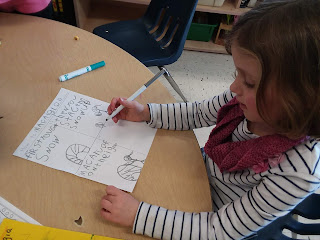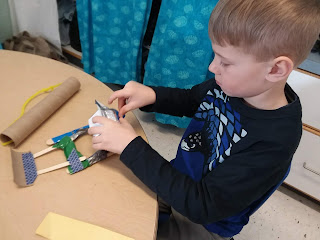- How to make a snowman
- How to make a tree house
- How to go to Florida
- How to ride a train
- How to make a s'more
- How to make an igloo
- How to make a bag
- How to get dressed to go outside
- How to go skiing
- How to go skating
- How to polish your nails
- How to hike a mountain
- How to make an ice cream sundae
Friday, February 21, 2020
For the last several weeks during writing we have been working on "How to" writing, explaining the steps for how to do or make something. We began this unit by reading several books including "Everyone Can Learn to Ride a Bicycle" by Chris Raschka and "Pizza at Sally's" by Monica Wellington. We did several whole class examples of procedural writing, listing the steps and using transition words like "first", "then", and "next". We also talked about the integral role pictures can play when telling someone how to do something. As a class we brainstormed a list of topics for this writing, from classroom routines to taking a trip, adding to the list as new suggestions arose. Children have had an abundance of ideas, including:
Saturday, February 15, 2020
To wrap up our science unit on motion (and for fun) this week we made mini sleds. Children had a wide assortment of recyclables along with materials like craft sticks and pipe cleaners and tape. Encouraged to use their imaginations and have fun, children came up with some very creative designs. Several had enclosed compartments so the passengers would stay warm, some had plows on the front, and we tested sleds on a cardboard ramp and made observations about the way they moved. We noticed the taller sleds tended to tip over and roll, sleds with smooth plastic bottoms slid down smoothly, and one sled moved so slowly down the ramp we decided to call it the slug sled. We concluded that this was because the tape on the bottom of it was creating friction and slowing it down.
Tuesday, February 11, 2020
We officially marked our 100th day of school on Monday. We began celebrating last Wednesday (day 99) with several fun activities. Children searched the room for 100 numbered tiles, which they matched to their corresponding number on a 100's chart. Most of these were in plain sight and pretty easy to find, but there are always a couple of elusive tiles. We did manage to find all of them by the end of the day. Children also had the option of making a string of 100 beads or a paper chain with 100 links. On Monday and Tuesday we played a board game to 100, built with 100 blocks and 100 cups, and did a search for tiny pictures of objects arranged in groups of 10 up to 100 (e.g. 30 buttons, 60 legos.) While celebrating the 100th day is mostly about recognizing a milestone and having fun, I find that emphasis on 100 for a day or two, (or six with snow days), can also deepen children's sense of our number system and how numbers to 100 are composed and written ad groups of 10 and additional ones.
Sunday, February 2, 2020
On Wednesday, Carrie came for an ECO session at school. Our focus was on animals in winter, particularly how they adapt to snow. After a story and game, we spent time building ruffed grouse houses. When we made our plans the snow was perfect for packing and our intent was to make little snow caves. The rain/sleet/ warm temperatures followed by cold made very interesting snow conditions - crust with a tiny layer of powder on top. Not so good for packing, but perfect for breaking off snow bricks and making mini-igloos. It was a beautiful morning to spend outside!
Subscribe to:
Comments (Atom)
























































